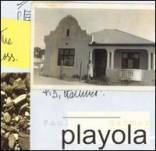Playola
by Paul Hanmer
–
Reviewed by Chris Mann
 Keyboard-player,
composer and producer Paul Hanmer was born in Cape Town.
His musical interest started at an early age.
In the early 70’s he began classical piano and theory lessons.
After three years at the University of Cape Town, studying for a
B.Mus. degree, Paul started working in a variety of different fields. Keyboard-player,
composer and producer Paul Hanmer was born in Cape Town.
His musical interest started at an early age.
In the early 70’s he began classical piano and theory lessons.
After three years at the University of Cape Town, studying for a
B.Mus. degree, Paul started working in a variety of different fields.
He
took leave of absence from UCT to work with guitarist Paul Peterson, who
introduced Paul to many musicians. He performed with Top-40 bands, did
jazz standards and played in several original bands.
In
1987 Paul Hanmer moved to Johannesburg and expanded his musical career
by working with various cabaret acts and played in musicals and theatre
productions. It was here that he formed “Unofficial Language” with
fellow Capetonian’s Ian Herman (drums) and Pete Sklair (bass).
Ten years later, on Sheer Sound records, he released his first album
“Trains to Taung” to huge critical acclaim.
“Playola” is the third of the four albums he has released as
a solo artist. Paul also
collaborated on Heads Up Records’ “Smooth Africa” project in 2000,
alongside such names as Jonathan Butler, Hugh Masekela, Andy Narell and
Joe McBride and a host of stars from the world of African music.
Adrian’s
Chord Intro/Echo opens
the album on a reflective note. The
solo piano piece gives hints already that this will not be the standard
smooth jazz fare.
Adrian’s
Chord is an ensemble piece, which grows like dawn breaking.
The cymbal work is subtle and enhances the piano melody, as do
the strings which provide lovely countermelodies.
Drummer Kevin Gibson marks the change of tempo confidently.
The
African feel that I’d expect from a musician hailing from Cape Town is
evident on Zondwa Stomp.
It’s quite a lazy sound and the repetitive marimba line sounds
like it’s running counter to the piano but listen and it fits
together. Peter Sklair’s
fretless bass and the chattering percussion make the song very
distinctive.
The
haunting Margaret Matheson is written in
waltz time. Gibson’s dancing
cymbals and Denis Lalouette’s warm and lilting 6-string bass are the
perfect accompaniment for the piano improvisations around a beautiful
central theme. This song
has drawn tears from me several times. These
few lines don’t do it justice.
The
mood is more upbeat – almost defiant – for Kwaito
Right. The bass is down in
the low registers and so is the piano much of the time.
McCoy Mrubata’s straightforward tenor starts to cook and this
is African funk we’ve got here! A
bluesy solo from guitarist Mabarane Mhlanga is the finishing touch – I
was already hooked!
The
9-minute title track takes time to build to its central theme. The piano plays a swaying, repetitive figure which is accented by
alto sax. The figure becomes
hypnotic and despite getting funkier in parts, its overall effect is
calming. Lalouette’s
lyrical bass solos are back in the mix but worth making the effort to
follow. Oh, I love this!
Electric
piano and acoustic bass are heard for the first time on the lovely Oulap’salms.
The languid brass on this tune reminds me of old Mongo Santamaria
records. Even if you
don’t read the fascinating liner notes, this music takes you far
away…
Barcarolle
is similarly atmospheric. Marimba
seems to carry this loping rhythm.
The cello is unexpected – it plays a supporting role to more
crystal-clear piano work and a highly assertive alto sax solo.
“Elegant”
is the most appropriate way to describe A Brand
New Waltz. Lovers of
jazz trios will be impressed by the size of the sound.
It’s a complex piece where chord changes bring mood changes
with them. There’s some
zany brushwork and percussion – while I’m smiling at that I can
still appreciate how impressive the whole is.
Amie
sounds almost Scottish in the intro but it opens out into
something much lighter, and it gets its sense of urgency from a strange
source. Drummer Ian Herman
pats his thighs throughout – in stereo.
A
brassy intro to 12/12/88 really makes a
statement. That strutting
rhythm carries it through, the piano is big and bold and the interplay
of trumpet, tenor sax and two trombones is both witty and complex.
Do I love the bass solo? Yes.
Do I love Gibson’s rimshots?
Yes. Even the outro
means business.
Solo
piano is just right for The Loss.
The liner notes make it clear that the sadness expressed is not
as profound as the title suggests. The
rise and fall of the melody hints at waves on the ocean and the song is
calming and reflective.
I
started out by saying that this CD did not promise to be typical smooth
jazz. And I’ll stand by
that: it’s much more than a collection of radio-friendly, 4-minute
treats. It’s a welcome into a culture which is different yet has
elements many of us recognise and enjoy.
As
such, it takes a few hearings to appreciate both its subtleties and its
grandeur. I’m very glad
that I’ve done that before sharing my thoughts with you.
Sheer
Sound SSCD056 – producers Paul Hanmer and Peter Pearlson
|

